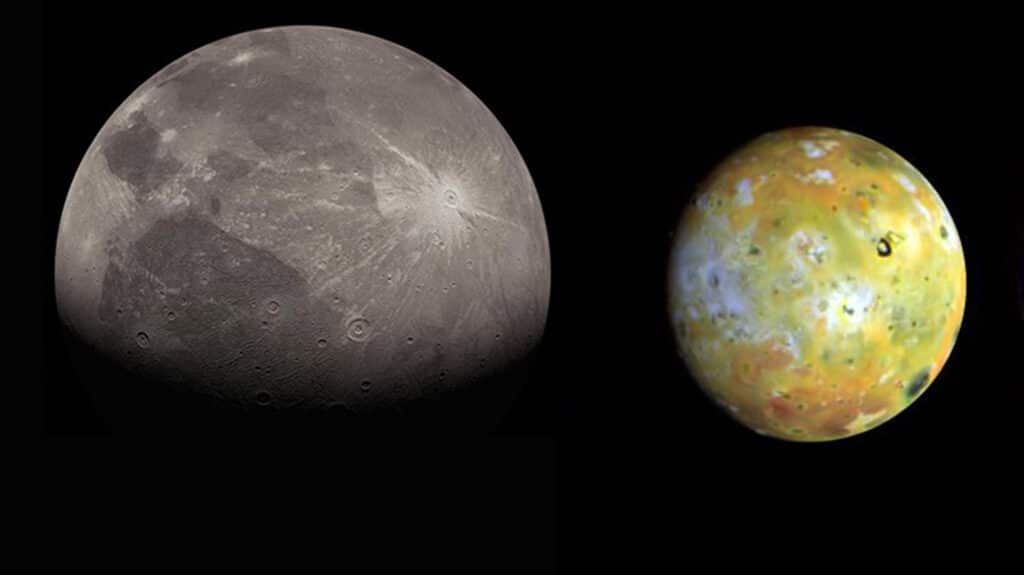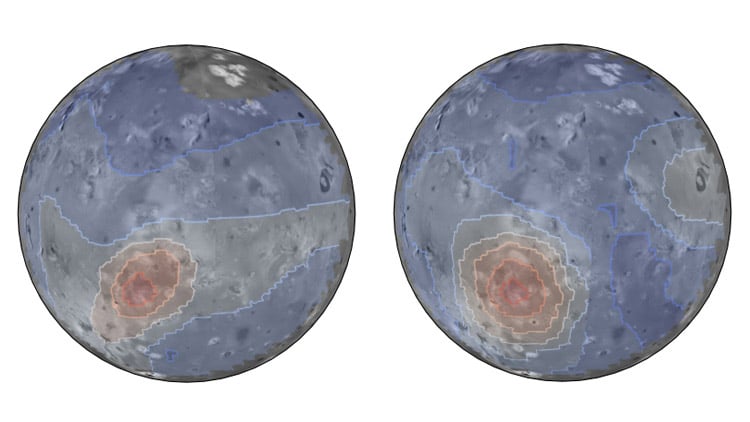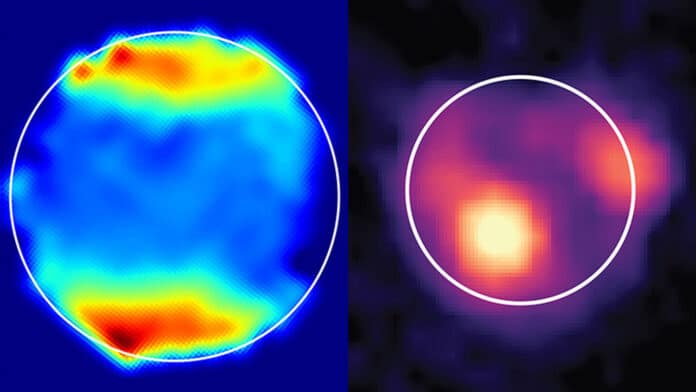Using its sensitive infrared cameras and high-resolution spectrometer, JWST is revealing new secrets about Jupiter’s Galilean satellites, particularly Ganymede and Io. The observations revealed the presence of hydrogen peroxide on Ganymede and sulfurous fumes on Io, both resulting from Jupiter’s domineering influence.
The study is another example of JWST can perform incredible science on solar system objects. The study is published in two separate publications.
As a result of charged particles from Jupiter and Ganymede impacting the moon’s ice, scientists discovered the absorption of light by hydrogen peroxide (H2O2) around the north and south poles of the moon using measurements taken by the near-infrared spectrometer (NIRSpec) on JWST.
Samantha Trumbo, a 51 Pegasi b postdoctoral fellow at Cornell University, led the study of Ganymede, said, “JWST revealing the presence of hydrogen peroxide at Ganymede’s poles shows for the first time that charged particles funneled along Ganymede’s magnetic field are preferentially altering the surface chemistry of its polar caps.”
The scientists contend that charged particles striking the ice at the poles make peroxide by fragmenting the water molecules. This process is known as radiolysis, which then recombines to form H2O2.
Because Ganymede, unlike all other moons in our solar system, Ganymede has a magnetic field that drives charged particles toward the poles, so scientists hypothesized that radiolysis would take place essentially there.

Scientists had earlier studied hydrogen peroxide on Europa. However, most of the surface of Europa had peroxide visible, possibly in part because it lacks a magnetic field to shield the surface from the fast-moving particles whizzing around Jupiter.
Trumbo said, “This is likely a critical and widespread process. These observations of Ganymede provide a key window to understand how much water radiolysis might drive chemistry on icy bodies throughout the outer solar system, including on neighboring Europa and Callisto (the fourth Galilean moon).”
Scientists noted, “It helps to understand how this so-called radiolysis works and that, indeed, it works as people expected, based on lab experiments on Earth.”
In a second paper, scientists reported observations of Io that show several ongoing eruptions, including a brightening at a volcanic complex called Loki Patera and an exceptionally bright eruption at Kanehekili Fluctus.
Studies like this provide planetary scientists a different viewpoint than that which can be gained by studying volcanoes on Earth because Io is the only volcanically active moon in the solar system—Jupiter’s gravitational push and pull heat it up—and because Io is the only moon in the solar system.
Using so-called “forbidden” transitions of the gas sulfur monoxide (SO), the researchers connected a volcanic eruption — at Kanehekili Fluctus — to a particular emission feature for the first time.

The primary gas in Io’s atmosphere is sulfur dioxide (SO2), produced by the sublimation of SO2 ice and continuing volcanic eruptions, much as how volcanoes on Earth make SO2. In addition to SO2, which is much easier to detect, volcanoes emit SO. The fact that SO is created in such low concentrations and for such a brief period of time after being excited makes it particularly difficult to detect the prohibited SO emission line.
Additionally, it is simpler to view the blazing SO gases when Io is under Jupiter’s shadow, so observations can only be done during that time. The SO2 gas in Io’s atmosphere freezes off onto its surface while it is in Jupiter’s shadow, leaving only SO and newly released volcanic SO2 gas in the atmosphere.
Imke de Pater, professor emerita of astronomy and Earth and planetary science at the University of California, Berkeley, said, “These observations with Webb show for the first time that this excited SO did come from a volcano.”
“The link between SO and volcanoes ties in with a hypothesis we had in 2002 to explain how we could see SO emission at all. The only way we could explain this emission is if the SO is excited in the volcanic vent at a temperature of 1500 Kelvin or so, and it comes out in this excited state, loses its photon within a few seconds, and that is the emission we see. So these observations are the first that show that this is the most likely mechanism of why we see that SO.”
Journal Reference:
- Samantha K. Trumbo, Micheal Brown, et al. Hydrogen peroxide at the poles of Ganymede. Science Advances. DOI: DOI: 10.1126/sciadv.adg3724
- Imke de Pater, Emmanuel Lellouch et al. An Energetic Eruption with associated SO 1.707 micron emissions at Io’s Kanehekili Fluctus and a Brightening Event at Loki Patera Observed by JWST. JGR Planets. DOI: 10.1029/2023JE007872
